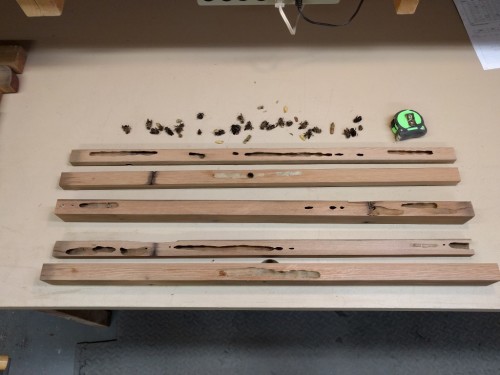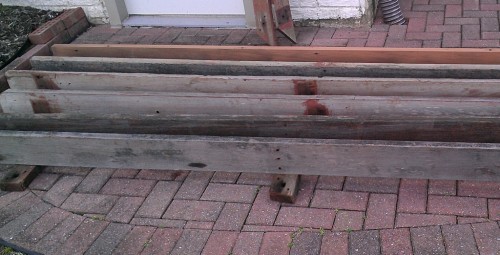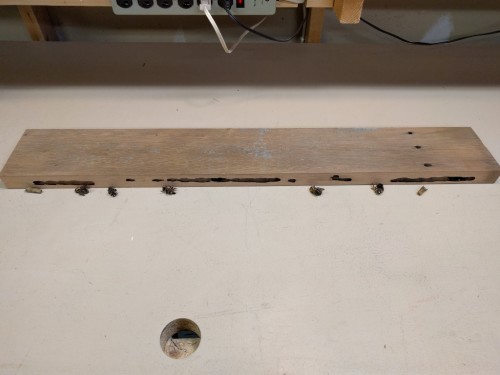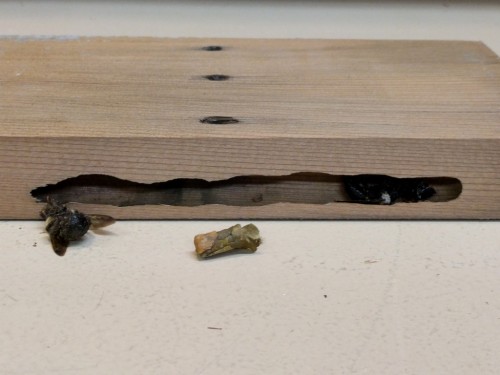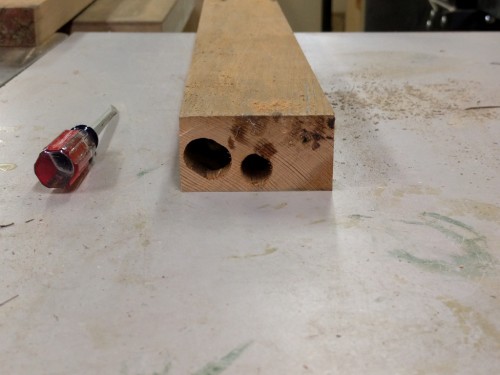When I reclaimed the lumber from an old redwood bench, I knew there were carpenter bees taking up residence in the wood but I had no idea how many – and how much damage they had caused. Boy, was I in for a surprise! The only external evidence of the bees was neat 1/2″ diameter holes on each 9 foot long board, about 3-4 holes per board. But once I started ripping the boards, the madness within was revealed.
Some of the carpenter bee entrance holes can be seen in the photo below (click the image for slightly better resolution). The second board from the front has one in the middle of the board about 2-1/2 feet from the left side. The rear-most planed board has three holes visible along the top edge. The slightly smaller holes in groups of three are nail holes. Typically, carpenter bees will create an entrance hole on the underside of a board, where it is protected from rain and the other elements, and dig in an inch or so. Then, they will turn 90 degrees and excavate nesting tunnels that run with the grain of the wood. Many of the tunnels I exposed were 8″ to 12″ long but several were about 2′ long!
The full extent of the damage from the bee tunnels became obvious once I started cutting the lumber into smaller pieces as the first step in creating a new garden bench. One of the most damaged boards is shown below. This lumber appeared to be old-growth redwood, worth a couple hundred dollars – as long as it was mostly salvageable. As it turned out, most of the wood was intact but every board had some level of damage that I had to deal with. That’s the subject for another article. Unfortunately, I had to put the bees to “sleep” with an insecticide dust in order to safely cut and handle the boards. I estimate there were about 30 bees living in the old bench. I really wasn’t expecting there to be that many bees and I felt bad as their losses mounted (carpenter bees are actually good pollinators). I promise to make it up in some way…perhaps I’ll create some bumble bee habitat…
It is common for carpenter bees to return to the same tunnel year after year, expanding the old passage ways and creating new ones to serve as brood chambers for their young. According to this carpenter bee fact sheet, each chamber is provisioned with a supply of “bee bread”, a mixture of pollen and regurgitated nectar, as a food source for the young. Shavings from the excavated tunnels are then used to create partitions between nesting cells. A single entrance hole will be shared by multiple females, each forming brood chambers in a separate branch off the main tunnel. The photo below shows a plug that came out of a brood chamber. I’m not sure if this is bee bread or a cell partition – I didn’t taste it to find out.
The ends of the bee tunnels were exposed on several boards after cutting the boards to length. Some of the tunnels were almost perfectly round, about 1/2″ in diameter (I assume these were the newer tunnels) while others were larger and more elongated (older, main passage ways). In a few instances, bees came tumbling out after cutting the board and tapping the end of the board against the floor. Some of the bees were still alive so that made things interesting in the wood shop. I entered the shop one morning and there were a couple bees flying around. Surprise!
All in all, it was a unique experience dealing with the carpenter bee infested wood. I’m moving forward with plans to recycle the wood into a new bench but the challenge will be to prevent new bees from burrowing into it. I’m sure there are lots of carpenter bees still living in the immediate area. Carpenter bees prefer soft, untreated wood so I intend to finish the bench with a spar varnish to dissuade them. I may also apply an additional coating to the underside of the bench – perhaps latex paint or a resin with insecticide embedded within. I’ll let you know how that works out.


